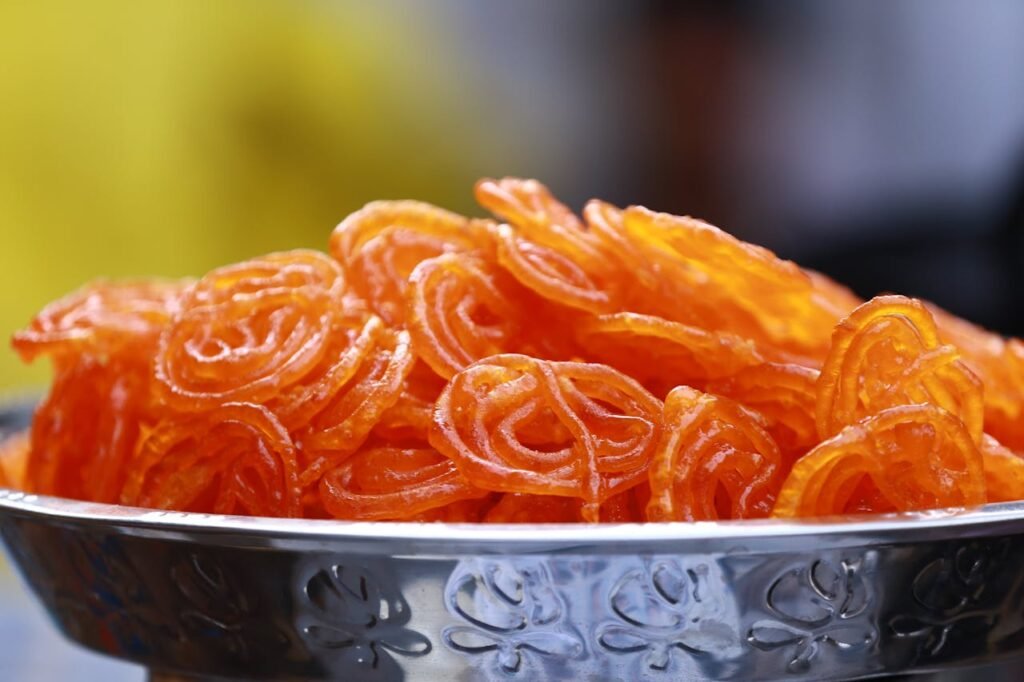Jalebi is a popular sweet dish that is commonly consumed in South Asia, including Pakistan, India, and Bangladesh. It is made by deep-frying a fermented batter in a pretzel or circular shape and then soaking it in a sugar syrup, which gives it a sticky and sweet texture.
The batter for jalebi is typically made from a mixture of all-purpose flour, yogurt or curd, and sometimes a small amount of semolina or rice flour. The batter is left to ferment for several hours or overnight, which helps to develop its distinct tangy flavor.
To make jalebi, the fermented batter is poured into a piping bag or a squeeze bottle with a fine nozzle. It is then shaped like a pretzel or piped straight into boiling oil. The jalebis are fried until they turn golden and crispy.
Once fried, the jalebis are immediately dipped into a warm sugar syrup. The syrup is often flavored with cardamom, saffron, or rose water to add fragrance and enhance the taste. The jalebis are allowed to soak in the syrup for a few minutes, which makes them soft, juicy, and incredibly sweet.
Jalebi is typically served warm and can be enjoyed on its own or paired with other desserts like rabri (thickened sweetened milk) or served alongside a cup of hot milk or tea. It is a popular treat during festivals, weddings, and special occasions, and is widely available from street food vendors and sweet shops throughout the region.
Here’s a recipe for making jalebi:
Ingredients
For the batter
- 1 cup all-purpose flour
- 1 tablespoon yogurt or curd
- 1 teaspoon semolina (optional)
- ½ teaspoon baking powder
- 1 cup water (approximately)
- A pinch of saffron strands (optional)
- Oil, for deep frying
For the sugar syrup
- 1 cup sugar
- ½ cup water
- ½ teaspoon cardamom powder
- A few strands of saffron (optional)
- 1 teaspoon rose water (optional)
Instructions
- In a mixing bowl, combine the all-purpose flour, yogurt, semolina (if using), baking powder, and saffron strands. As you mix, gradually add water to create a homogeneous batter. The texture ought to resemble pancake batter. Let the batter rest for at least 30 minutes to 1 hour to ferment.
- In the meantime, prepare the sugar syrup. In a saucepan, combine sugar and water. Place it over medium heat and stir until the sugar dissolves completely. Add the rose water (if using), saffron threads, and cardamom powder. The syrup has to simmer for 5 to 7 minutes to slightly thicken. Remove from heat and set aside.
- Over medium heat, warm the oil in a deep frying pan or kadai. While the oil is heating, fill a squeeze bottle or piping bag fitted with a small nozzle with the fermented batter.
- Once the oil is hot, carefully pipe the batter into the hot oil, forming circular or pretzel-like shapes. Fry a few jalebis at a time, taking care not to overcrowd the pan. Fry till golden brown and crispy. To ensure equal cooking, turn them occasionally.
- Once fried, remove the jalebis from the oil using a slotted spoon and drain the excess oil. Transfer the jalebis directly into the warm sugar syrup, allowing them to soak for about 1-2 minutes.
- Remove the jalebis from the syrup and drain any leftover syrup on a serving platter or wire rack.
- Repeat the frying and soaking process with the remaining batter until all the jalebis are prepared.
- Serve the jalebis warm or at room temperature. They are best enjoyed fresh and can be served as is or with a side of rabri, sweetened milk, or enjoyed on their own.
Note: Jalebis are traditionally served warm, but you can store them in an airtight container at room temperature for a day or two. Reheat them slightly before serving if desired.
Enjoy your homemade jalebis!
Share this content:


